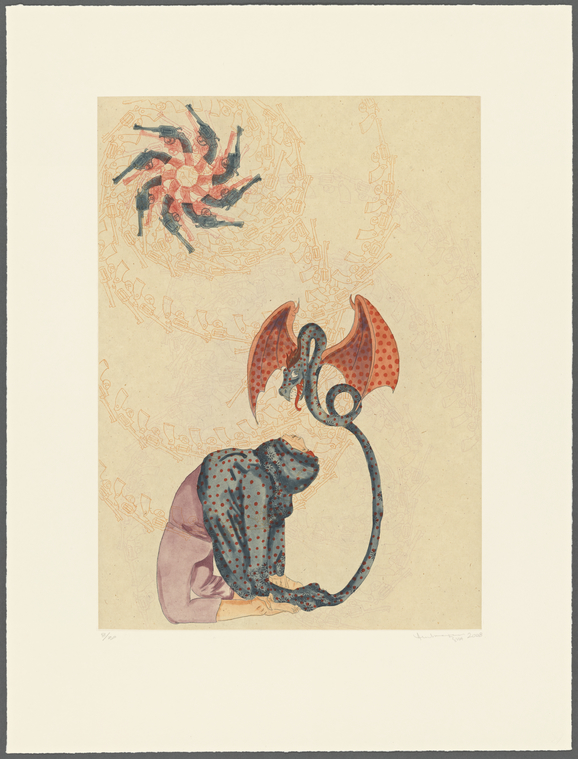Printing Women: Ambreen Butt
While the exhibition Printing Women focuses on Henrietta Louisa Koenen’s (1830–1881) collection of female printmakers from the 16th to 19th centuries, it is only appropriate to signal women’s continuing participation in the medium as well as the Library’s longstanding commitment to acquiring and exhibiting prints made by women from around the world. To complement this earlier history, therefore, I worked with the Library’s Digital Experience Team to display online a small sampling of works by contemporary printmakers in the Library’s collection. We began reaching out to artists, asking if we could display their work on the exhibition’s web page and digitize it for our digital collections. The majority were delighted to contribute, many also provided writings about their work and the exhibition. Throughout the exhibition’s run, I will choose and present a piece by one artist every other week on the exhibition’s web page. Additionally, I will produce a blog post about their work as well as about works in the exhibition, featuring their own words when possible.
For those who are interested in the long history of women’s involvement with the medium of print, there is much more to explore within the Library’s deep and varied holdings. The exhibition features only a smattering of Koenen’s collection (which numbers over 500 prints of which only a little over 80 are shown in the exhibition). In addition, the Print Collection not only owns large numbers of additional prints from the period in which Koenen collected, but also many, many more works from the 20th- and 21st-century.
The sixth blog post in our series is by Ambreen Butt about her piece, (Untitled) Dragon Woman, 2008.
On (Untitled) Dragon Woman by Ambreen Butt
"(Untitled) Dragon Woman is one in a suite titled Daughters of the East which is part of a larger series called Dirty Pretty. The idea behind that series is one of images of beauty that carry complicated and difficult narratives, the beauty of the image making it easier to face the ugliness of the narrative. The series came about after a trip back to Pakistan in 2007 after having been away from the country for twelve years.
Daughters of the East were created in response to a specific 2007 incident in Islamabad, the military siege of Lal Masjid, the Red Mosque, which is one of the oldest mosques in Islamabad and a conservative center of teaching for both men and women. The clerics of the Lal Masjid have often been in conflict with the government administration, and in 2007 there were a series of events that left, depending on your sources, ninety people dead and hundreds wounded. Female students of Lal Masjid were active in the protests, and my prints are based on press images from that event.
In one image there is a group of women all wearing black burkas and weilding bamboo sticks. They seem very threatening, but the majority are of a very tender age, about 15 to 20 years old. They are from poor backgrounds and are the noble and darling daughters of unprivileged parents. So there is an element of delicacy, of sadness and vulnerability that isn’t readily apparent to the viewer. The girls were highly influenced by the mosque's teachings, and many died after the siege.
The first print in the suite juxtaposes two different iconographies: ladybugs and the image of clustered women in black. Each symbolizes delicacy and infestation simultaneously. Individually, a ladybug is a symbol of good luck, while a colony of them becomes something quite different and toxic. In the same way, the women are also young and delicate girls behind the black veil, but in a group they portray a different image and have a different identity. Towards the end of the suite, I celebrate the individual over the group, and give a real face to the female in the black veil. Throughout, the images are composed of systematic mark making, celebrating the mundane practice of building images that inscribe a narrative. The narrative in this small series evolves against a background of the ladybugs."
Read E-Books with SimplyE
 With your library card, it's easier than ever to choose from more than 300,000 e-books on SimplyE, The New York Public Library's free e-reader app. Gain access to digital resources for all ages, including e-books, audiobooks, databases, and more.
With your library card, it's easier than ever to choose from more than 300,000 e-books on SimplyE, The New York Public Library's free e-reader app. Gain access to digital resources for all ages, including e-books, audiobooks, databases, and more.
If you don’t have an NYPL library card, New York State residents can apply for a digital card online or through SimplyE (available on the App Store or Google Play).
Need more help? Read our guide to using SimplyE.
